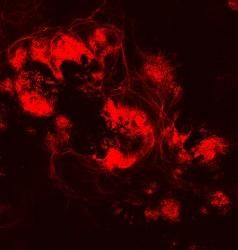Imaging Against Multiple Sclerosis
An Iodinated Radiotracer Candidate for PET and SPECT Imaging
A first-line treatment for relapsing forms of multiple sclerosis (MS) was approved in September 2010 by the US Food and Drug Administration: FTY720 (fingolimod, Gilenya), which acts as a sphingosine 1-phosphate (S1P) receptor modulator. There is preclinical evidence that in addition to decreasing infiltration of lymphocytes into the central nervous system (CNS), FTY720 may provide additional neuroprotection through modulation of cerebral S1P receptors. To further study the action of FTY720 in the CNS, Emmanuelle Briard, Yves Auberson, and colleagues at the Novartis Institutes for BioMedical Research in Basel (Switzerland) evaluated a series of iodinated FTY720 derivatives that could be used to study the drug's brain distribution in patients using nuclear imaging techniques, and their results are reported in ChemMedChem.
After extensive profiling, they identified 2-iodo-FTY720 (BZM055) as a close mimic of FTY720, having similar physicochemical properties and organ distribution, despite the addition of an iodine atom. They also showed that BZM055 is phosphorylated into its biologically active form at a similar rate to FTY720, retaining an affinity and selectivity for S1P receptors comparable to FTY720-phosphate, as well as similar brain penetration kinetics. [123I]BZM055 is currently being developed as a SPECT tracer for studying the pharmacokinetics and distribution of FTY720 in the human brain. In addition, and since FTY720 has been shown to accumulate in myelin sheaths, this tracer might also prove useful to image myelin in MS patients.
Original publication
Other news from the department science

Get the life science industry in your inbox
By submitting this form you agree that LUMITOS AG will send you the newsletter(s) selected above by email. Your data will not be passed on to third parties. Your data will be stored and processed in accordance with our data protection regulations. LUMITOS may contact you by email for the purpose of advertising or market and opinion surveys. You can revoke your consent at any time without giving reasons to LUMITOS AG, Ernst-Augustin-Str. 2, 12489 Berlin, Germany or by e-mail at revoke@lumitos.com with effect for the future. In addition, each email contains a link to unsubscribe from the corresponding newsletter.





















































